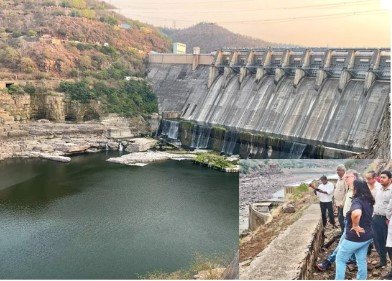Hyderabad: An impending disaster is brewing at the Srisailam Dam, as severe damage in the plunge pool area downstream of the spillway threatens the structural stability of this vital lifeline for Andhra Pradesh and Telangana. In a dire warning, N. Anil Kumar, Chairman of the Telangana State Committee on Dam Safety (SCDS) and Engineer-in-Chief (General), has alerted the National Dam Safety Authority (NDSA) about the urgent need for action to prevent a potential catastrophe.
A Crucial Lifeline at Risk

Built in 1981 across the Krishna River, the Srisailam Dam is a multipurpose project that plays an indispensable role in the lives of millions. It generates hydroelectric power with an installed capacity of 900 MW for Telangana and 770 MW for Andhra Pradesh. Additionally, it supports irrigation and drinking water needs across vast regions in both states and is pivotal to the Telugu Ganga Project, which supplies drinking water to Chennai. The dam also serves as a critical component for flood control.
Severe Deterioration of Plunge Pool
Recent inspections, combined with media reports, reveal alarming deterioration in the plunge pool area downstream of the spillway. The unprecedented discharge of about 25 lakh cusecs during the 2009 floods, far exceeding the dam’s designed capacity of 14 lakh cusecs, caused significant scouring and left a massive void in the plunge pool. This has raised serious concerns about the dam’s safety and long-term stability.
Studies conducted by the National Institute of Oceanography, commissioned by the Andhra Pradesh Government, confirm severe erosion in the plunge pool area. If left unaddressed, this could compromise the overall structural integrity of the dam, which stands at a maximum height of 143.26 meters from its deepest foundation level.
Catastrophic Consequences of a Breach
Experts warn that a breach in the Srisailam Dam could unleash an enormous volume of water, leading to devastating flooding across downstream areas in Andhra Pradesh and Telangana. The potential consequences could be catastrophic, resulting in:
- Widespread destruction of power and irrigation infrastructure.
- Severe disruption of drinking water supplies.
- Massive humanitarian impacts affecting lakhs of residents.
The threat doesn’t end there. A breach at Srisailam could also jeopardize the safety of other key infrastructures, including Nagarjuna Sagar Dam, Pulichintala Dam, and Prakasam Barrage. This would lead to extensive resource losses in irrigation, power generation, and drinking water supply systems crucial for Andhra Pradesh, Telangana, and even Chennai through the Telugu Ganga Project.
Call for Immediate Action
In his urgent communication to the NDSA, the SCDS Chairman urged the deployment of an expert team to conduct a comprehensive assessment of the plunge pool damage and evaluate the structural integrity of the dam. He stressed the necessity of both immediate temporary solutions and long-term rehabilitation measures to safeguard the dam.
Among the recommended temporary measures is the deployment of interlocking tetrapods to enhance energy dissipation and prevent further scouring, especially in anticipation of the upcoming rainy season. Additionally, a coordinated action plan is needed to initiate long-term strategies for the rehabilitation and safety of the dam.
A Race Against Time
The gravity of the situation cannot be overstated. The continued safe operation of the Srisailam Dam is vital not only for the safety and livelihoods of millions but also for maintaining hydropower generation, irrigation, and drinking water supplies across Andhra Pradesh, Telangana, and Chennai.
If preventive measures are not taken promptly, the consequences could be catastrophic, affecting the lives of hundreds of thousands of people and causing irreparable damage to critical infrastructure. The call for action is clear: safeguarding the Srisailam Dam is not just about preventing a disaster—it is about protecting the future of Andhra Pradesh, Telangana, and Chennai.


